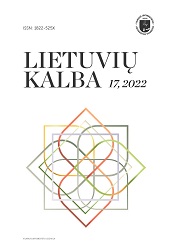Konkuruojanti lokatyvinių konstrukcijų vartosena rytų aukštaičių vilniškių ir pietų aukštaičių patarmėse: priežastys ir tendencijos
Competitive use of the locative constructions in the Eastern Aukštaitian subdialect of Vilnius and Southern Aukštaitian subdialect: Causes and tendencies
Author(s): Daiva Kardelytė-GrinevičienėSubject(s): Morphology, Semantics, Baltic Languages
Published by: Vilniaus Universiteto Leidykla
Keywords: locative construction; inessive; illative; competition; semantics; Eastern Aukštaitian subdialect of Vilnius; Southern Aukštaitian subdialect;
Summary/Abstract: This article is a continuation of previous studies of the interaction between the locative inessive and illative constructions in the Eastern Aukštaitian subdialect of Vilnius and Southern Aukštaitian subdialect. This study focuses on one aspect of the interaction between the locative inessive and illative constructions – the competitive use of the locative constructions. The article presents the types of such use, discusses the reasons of their formation and the tendencies of their functioning. The morphological and semantic aspects of the competition of the constructions studied are discussed using the comparative and descriptive research methods, the research is based on the principles of cognitive semantics and perceptual dialectology. Three competitive types of the use of locative constructions are distinguished: 1) in trinary locative constructions verb + pronoun (less frequently – adjective/numeral) + noun, pronoun is used in the illative case, and noun is used in the inessive case; 2) in binary locative constructions, the inessive of the prototypically used noun is replaced by the illative; and 3) in binary locative constructions, the illative of the prototypically used noun is replaced by the inessive. One of the possible motives for the formation of this use is the assimilation of the inessive and illative forms tam and tan of the masculine pronouns after the morphological and systematic shortening of the paradigmatic cases. According to the pronoun example, the competition could also spread in locative constructions with numerals and adjectives. Another possible motive is the identical ending -a of masculine plural inessive and illative cases, e.g., kambariuosa and kambariuosna; laukuosa and laukuosna. However, these morphological arguments do not explain why in some cases inessive and in other cases illative forms are chosen in the constructions, and therefore the paper makes a further assumption that the competitive use of locative constructions may have been caused by the closely interrelated semantic functions of the inessive and the illative, and the strong semantic potential of the verb. The data of subdialects shows that the competition of locative constructions is an ongoing process in the Eastern Aukštaitian subdialect of Vilnius and Southern Aukštaitian subdialect, but it is difficult to predict the future tendencies of the use of competitive locative constructions. The assumption is made that this could depend not only on morphological and semantic linguistic factors, but also on the linguistic attitudes of ordinary language users.
Journal: Lietuvių kalba
- Issue Year: 2022
- Issue No: 17
- Page Range: 61-69
- Page Count: 9
- Language: Lithuanian

